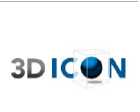
3DIcon Corporation
Ticker: TDCP
Traded on: OTCBB
Recent Stock Price: $.27 3 Month Avg. Volume: 109K Market Capitalization: $32 M Shares Outstanding: 120 M
Float: 40 M
52-Week Range: $.21 - $1.20
Most Recent SEC Filings: 10Q for Q Ended September 30, 2007
Investors Relations Contact: Dilek Mir 646-223-3353relations@3dicon.net
Prepared by:
For:
3DIcon CorporationP.O. Box 470941 Tulsa, OK 74147-0941
3DIcon Corporation (the "Company") is a developer of groundbreaking 3D projection and display technologies that are being designed to produce full color, 360o volumetric images. Its proprietary technologies are revolutionary in that they are being developed to leapfrog traditional methods of creating 3D images on a 2D screen. 3DIcon's mission is to create true-to-life 3D images that appear solid as viewed from any angle with the naked eye. Although there are numerous devises, including MRIs and scanners that capture 3D images, the 3D data is inevitably displayed on a 2D screen. 3DIcon sees a tremendous market opportunity in commercializing 3D projection devices to complement the 3D image capturing equipment already on the market. The myriad of applications for the Company's developing technologies include scanning for medical; homeland security needs; geo-spatial imaging for oil & gas exploration; air traffic control; entertainment; advertising; and gaming. 3DIcon's research is conducted through a Sponsored Research Agreement (SRA) with the University of Oklahoma (OU).
__________________________________________________________________________________
Intellectual Property Portfolio
3DIcon has the exclusive worldwide rights to technologies developed by OU, under the auspices of its SRA. To date several utility patents have been filed and the Company believes that additional patents, copyrights, and trademarks will flow from its research activities at OU. 3DIcon's platform 3D technologies include 3D-SVD (swept volume display) and CSpace(TM)(closed space) 3D rendering methods.
Research at University of Oklahoma
The Company has established an SRA with OU, whereby 3DIcon's technologies are being developed by leading researchers and scientists in multiple disciplines on two campuses. OU is one of the leading research institutions in the U.S. In the past 20 years, OU-developed technologies have led to the formation of 30-plus companies that have generated over $65 million in revenues. In 2006 alone, OU's researchers were awarded 19 patents, and processed 51 intellectual property disclosures. OU's research center hosts scientific research on some of the most important advancements of our day including work on the genome project, NASA, the National Weather Center, telecommunications and with the sponsorship of 3DIcon, OU is now emerging on the forefront of 3D projection technologies.
$1 Billion Market by 2011
According to Insight Media, the market for 3D display technologies is currently estimated at $345 million in 2007 for products currently on the market, most of which require viewing aids and utilize a 2D screen. As technology advances the market is expected to reach over $1 billion by 2011.
3D-SVD
3DIcon, through its OU research team, has recently completed a proof-of-concept prototype of its SVD 3D projection technology. A 3D image is formed by illuminating a rapidly moving display surface's algorithmically aligned image panes rotating at an optimal rpm. A collection of voxels are rendered at precise locations and times within the swept volume resulting in a 3D image due to persistence of vision. The 3D-SVD technology developed by 3DIcon lends itself to scalable 3D projection in large, outdoor formats, with strong brightness characteristics and is particularly well suited for entertainment and advertising.
CSpace(TM)
The Company's CSpace(TM)technology uses a clear non-moving projection medium into which invisible light sensitive nano-materials have been embedded. A 3D image is created when laser beams are projected onto the nano-materials, activating them to display the three primary colors to create a solid-appearing, full color, volumetric image. To date the OU team has successfully produced the clear projection medium with one color nano-materials. A one-color 3D image is expected by the end of Q1 2008. CSpace(TM)technology is best suited for applications in: a)scanning for medical and security purposes; b)entertainment and gaming; and c)geo-spatial for military, air traffic control, weather mapping and oil and gas exploration.
